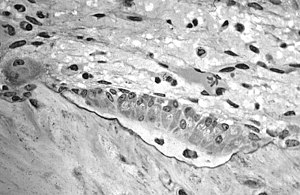Mangano C et al. From Plos One – accelerating the publication of peer-reviewed science.
The aim of this study was to evaluate the behavior of human Dental Pulp Stem Cells (DPSCs), as well as human osteoblasts,when challenged on a Biocoral scaffold,which is a porous natural hydroxyapatite. For this purpose, human DPSCs were seeded onto a three-

Image via Wikipedia
dimensional (3D) Biocoral scaffold or on flask surface (control). Either normal or rotative (3D) cultures were performed. Scanning electron microscopic analyses, at 8, 24 and 48 h of culture showed that cells did not adhere on the external surface, but moved into the cavities inside the Biocoral structure. After 7, 15 and 30 days of culture, morphological and molecular analyses suggested that the Biocoral scaffold leads DPSCs to hook into the cavities where these cells quickly start to secrete the extra cellular matrix (ECM) and differentiate into osteoblasts. Control human osteoblasts also moved into the internal cavities where they secreted the ECM. Histological sections revealed a diffuse bone formation inside the Biocoral samples seeded with DPSCs or human osteoblasts, where the original scaffold and the new secreted biomaterial were completely integrated and cells were found within the remaining cavities. In addition, RT-PCR analyses showed a significant increase of osteoblast-related gene expression and, above all, of those genes highly expressed in mineralized tissues, including osteocalcin, OPN and BSP. Furthermore, the effects on the interaction between osteogenesis and angiogenesis were observed and substantiated by ELISA assays. Taken together, our results provide clear evidence that DPSCs differentiated into osteoblasts, forming a biocomplex made of Biocoral, ECM and differentiated cells.










